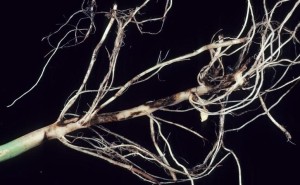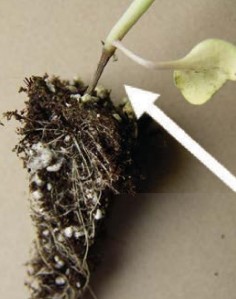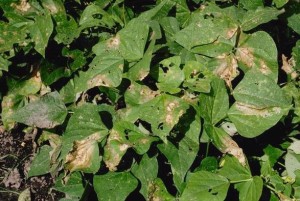Rhizoctonia diseases commonly affect vegetable crops, as well as fruit, ornamentals, and agronomic crops. Plant roots and stems primarily become affected, resulting in rot, but foliar blights and fruit rots may also occur. Use of cultural practices and fungicides can limit damage from Rhizoctonia diseases.
Rhizoctonia Facts
- Symptoms vary depending on crop and type of infection.
- Damping-off may develop when seeds become infected either pre- or post-planting. Pre-emergent damping-off occurs when seedlings fail to emerge from soil. Post-emergent damping-off occurs when seeds germinate, but seedlings develop lesions on roots or stems near the soil line, resulting in plant collapse (Figure 1). These symptoms may occur on many vegetable crops.
- Wirestem develops on seedlings or transplants after planting. Symptoms include constriction of the stem near the soil line (Figure 2), which may ultimately cause stunting and reduction of yield. Over time, affected plants may wilt and die. Cole crops are most commonly affected by wire stem.
- Symptoms of root and stem rot include the formation of circular to elongate, dry, sunken lesions at or below the soil line (Figure 3). Lesions may appear reddish-brown on some hosts and dark brown to black on others. Over time, lesions enlarge and girdle roots and stems, resulting in plants becoming stunted and wilted. Many vegetable crops may exhibit these symptoms once infected.
- Crown rot results when the base of plants become infected. Symptoms include the development of dark brown, oval lesions on lower leaves and crown of the plant (Figure 4). Over time, leaves droop, rot, and turn black, resulting in plant collapse. Crown rot is common in leafy vegetables, such as cabbage and lettuce.
- Above-ground portions of plants may become infected. Symptoms include web blight, which appears as large, irregular spots, wilting, and brown, dead stems (Figure 5). During periods of high humidity, fungal strands may develop and appear as “webbing” on plant tissues. These symptoms are most common on beans.
- Fruit may also be affected by Rhizoctonia diseases, resulting in fruit rot. Infected fruit may appear discolored and develop a wet rot on areas that are in contact with soil (Figure 6). Lesions eventually become sunken, dry, and irregular in shape. Symptoms may further develop during post-harvest storage of fruit. Cucurbit and solanaceous crops are often the most commonly affected.
- Potato tubers may specifically develop a disease called black scurf, in which small, black flecks (fungal survival structures) appear on the skins of tubers.
- Rhizoctonia spp. inoculum may be introduced via infected seeds or transplants, crop debris, or through infested soil.
- Rhizoctonia spp. diseases may be spread through water (irrigation or rain) or infested soil.
- Warm, wet conditions and periods of high humidity favor disease development.
- Rhizoctonia diseases are caused by multiple fungal species of Rhizoctonia.






Management
- Purchase certified disease-free seeds or transplants.
- Utilize cultivars with resistance, when available.
- Utilize soil solarization.
- Increase plant spacing.
- Avoid overhead watering.
- Trellis or stake plants to limit contact with soil.
- Remove and destroy infected plants or plant parts during the growing season.
- Clean and sanitize tools, pots, and equipment.
- Remove and destroy plant debris at the end of the season.
- Avoid storing infected or symptomatic fruit.
Commercial growers can find information on fungicides in the Vegetable Production Guide for Commercial Growers (ID-36) and the Southeastern U.S. Vegetable Crop Handbook (SEVEW). Homeowners should consult Home Vegetable Gardening (ID-128) for fungicide information or contact a county extension agent for additional information and recommendations regarding fungicides.
Additional Resources
- Rhizoctonia Diseases in Specialty Crop Production (PPFS-GEN-21)
- Home Vegetable Gardening (ID-128)
- Vegetable Production Guide for Commercial Growers (ID-36)
- Southeastern U.S. Vegetable Crop Handbook (SEVEW)
By Kim Leonberger, Plant Pathology Extension Associate, and Nicole Gauthier, Plant Pathology Extension Specialist
